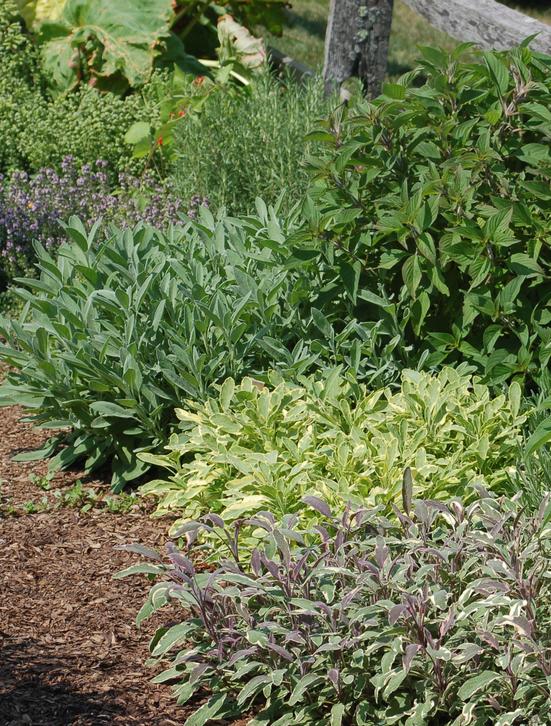Planting Herbs Outdoors
Herbs can be planted as established plants purchased from the nursery or can be planted from seed. Planting from seed requires a lot more work and can be a less successful experience for the uninitiated. Some plants cannot be grown from seed, such as comfrey and tarragon. Others, such as mints, do not come true from seed and are not worth growing from seed. Still others, like rosemary and lavender, take forever to germinate and grow so slowly that it is better to acquire established plants.
- Plant your potted plants on a cloudy day, and treat them like a fish out of water when you take them out of the pot. Before you do that, have everything ready. Dig a hole a little wider than the size of the pot. Never try to squeeze the roots into a small hole. Mix the soil you have removed with some composted manure (not dehydrated manure) or well-decomposed compost. Usually, the plant will pop out of its container easily if you turn it over and tap the bottom, but if it sticks, insert a knife around the edge, just as if you were taking a cake out of a pan. If the plant is tangled with roots or root-bound, use a sharp knife or pruners to score the roots about 1" into the soil ball at quarter-hour intervals or tease the roots loose with your fingers. Set the plant at the same depth as it was in the pot. Fill the hole around the plant with the mix of soil and compost, firming the soil thoroughly, leaving no air pockets to dry out the roots. Leave a slight depression around each plant or make a dam around it to catch the rain and future watering.
- Watering: Water potted plants immediately after planting. Add a bit of liquid seaweed, fish emulsion, composted manure, or liquid fertilizer to get the plant off to a good start. Continue to water every day for a week or two unless it rains hard.
- Fertilizing: Once the plants are in the ground, I do not fertilize. The plants should not need fertilizer, if you have beefed up your soil according to the soil test. For those in my greenhouse, I spray with compost tea.
- Mulching: I like to mulch all my plants. It moderates the temperature of the soil, it improves the appearance of the garden, it prevents the growth of many weeds, it conserves soil moisture, and it keeps the plants clean of rainwater splashes. Mulch materials can include grass clippings, which I mix with shredded straw to prevent them from matting. Straw is an excellent mulch as are shredded leaves. Try to find salt marsh hay, which has no weed seeds. If your soil is alkaline, pine needles will add a little acid and is also a good mulch, but go easy as they can burn the stems of plants and rob precious nitrogen from the soil.
- Weeding: Weeds have a worthwhile purpose. They protect soil from erosion and build up the soil. Don't we all wish they did their job less efficiently? My advice is to know your enemies. Learn to identify the most common weeds in your area, find out how they grow and how they reproduce, and you will be better equipped to control them. It will take a few minutes a day or a few hours twice a week to keep ahead of the weeds and not let them get a foothold. I weed by hand. Chemical weed killers end up in the ground water and cause more problems than they are worth. Also, you're eating these plants-you don't want to eat harmful chemicals! I get some satisfaction in eating my enemies, though. Chickweed, dandelions, and lamb's quarters are excellent in salad and more nutritious then some of the plants you may be growing. A rule of thumb: if a plant reproduces by scattering seed (dandelions), cut them down before they begin to scatter their seed. If they are aggressive (quackgrass, also known as witchgrass, and twitch grass, comfrey, mints, Jerusalem artichoke, tansy, horseradish), do not till. Quackgrass grows where soil has been compacted, such as in the garden paths. I have had some success with hardwood sawdust. Just mulch the paths. Never mulch around plants with sawdust; it will burn and rob like pine needles.
- Pests: Here are a few preventive measures to avoid pest problems-keep your plants healthy and vigorous, and leave plenty of space around them for good air circulation. Overcrowded, undernourished plants are prone to disease and pests. Disease and insects over-winter in debris such as stalks and old leaves. Clean up the garden. Compost spent plants. Inspect your plants frequently. Snip off spotted leaves or stems. Remove any plant that looks hopelessly sick. You might want to have a good disease and pest identification book in your reference library, so you can fight the problem once you know what it is. Pick off bugs in early morning when they are cold and sluggish, and drop them in soapy water. Fight back with natural enemies. Gardens Alive is a mail order company whose catalog you may want to become acquainted with because they sell natural predators that prey on the bad bugs. Some diseases are spread by wind and there's no amount of composting or cleaning up that is going to protect your plants. Fortunately, these do not affect herbs. For mildew, use powdery mildew sprays. For slugs, set out beer traps. If you can't control the Japanese beetles by hand picking, spread milky spore in the fall inquire at your local nursery. This will kill the grubs before they emerge.

Planting Herbs Outdoors
